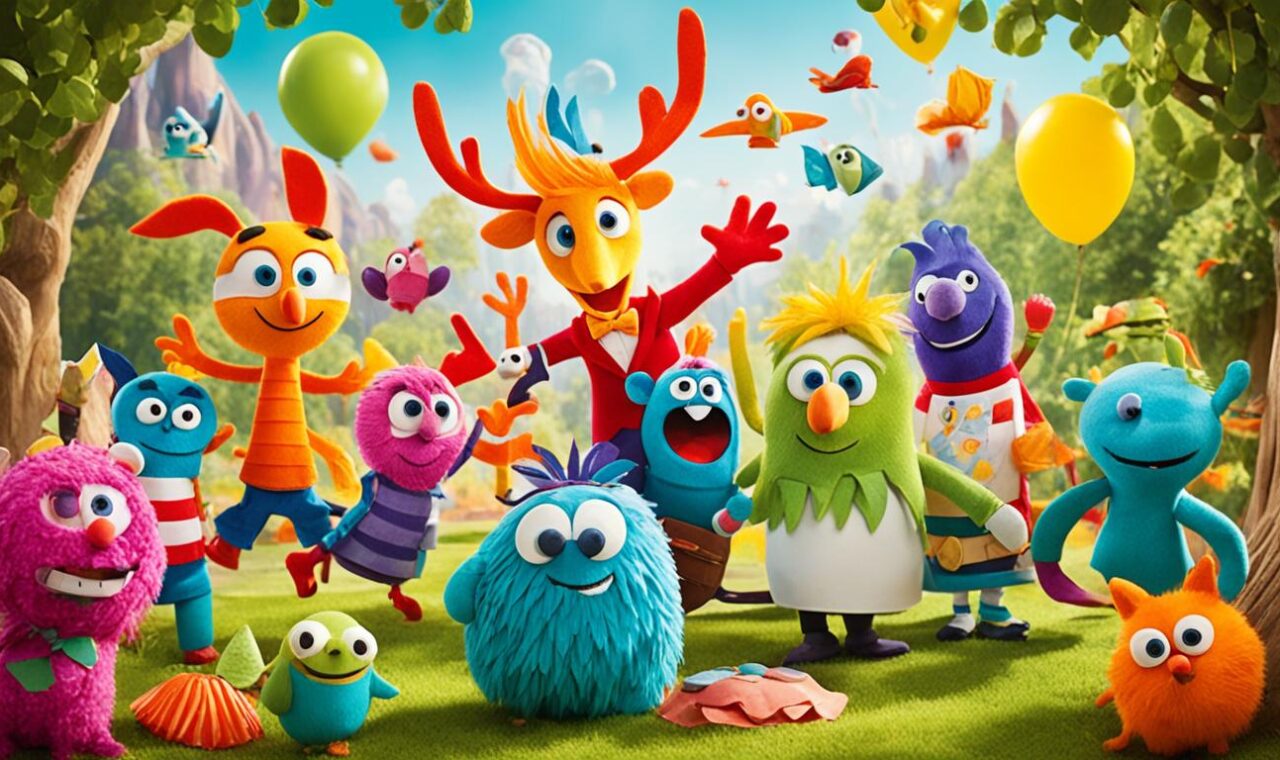Welcome to my guide on creating memorable children’s book characters! In this article, I will share valuable tips and techniques to help you bring your characters to life and captivate young readers. Whether you’re a seasoned author or just starting out, these strategies will ensure that your children’s book characters leave a lasting impression.
Creating memorable characters is key to crafting a successful children’s book. The characters you develop will not only entertain but also inspire and educate young readers. By implementing the tips and techniques I’ll discuss, you’ll be able to create characters that resonate with children of all ages.
Let’s dive into the world of character creation, starting with understanding your target audience. By understanding children’s reading habits and designing age-appropriate characters, you can effectively engage young readers.
Key Takeaways:
- Create characters that leave a lasting impression.
- Understand your target audience and their reading habits.
- Develop unique traits and craft relatable characters.
- Create visually appealing characters through illustrations and vibrant colors.
- Incorporate backstories and motivations to add depth to your characters.
Understanding the Target Audience
When it comes to creating memorable characters for children’s books, understanding your target audience is the first step towards success. As an author, it’s essential to dive into the world of your young readers and get a glimpse of their reading habits. This understanding will enable you to design age-appropriate characters that resonate with them and capture their imagination.
Children’s reading habits vary based on their age, interests, and cognitive development. Younger children, such as preschoolers and early elementary school students, usually enjoy colorful illustrations and simple storylines. They are drawn to characters who are relatable and represent familiar experiences in their lives.
As children grow older, their reading interests evolve. Middle-grade and young adult readers seek characters who face realistic challenges and tackle complex emotions. They yearn for protagonists who undergo personal growth and inspire them to overcome their own obstacles.
To create age-appropriate characters, it’s important to consider the cognitive and emotional development of your target audience. Characters should reflect their experiences and speak to their interests. By doing so, you will cultivate a deeper connection between your young readers and your stories.
“Understanding the target audience is essential in catering to children’s reading preferences and ensuring that your characters captivate their imagination.”
When crafting age-appropriate characters, keep in mind that diversity and representation are important aspects to consider. Children benefit from seeing characters from different backgrounds, abilities, and identities. By including diverse characters in your stories, you not only foster inclusivity but also help children develop empathy and expand their understanding of the world around them.
Now that we’ve explored the significance of understanding the target audience and designing age-appropriate characters, we can dive deeper into the art of character development. In the next section, we will focus on techniques for developing a strong personality that engages readers and creates memorable experiences.
Developing a Strong Personality
A strong personality is the key to creating a memorable character that stays with readers long after they have closed the book. When crafting characters for children’s books, it’s essential to develop unique traits that make them stand out and resonate with the young readers. By creating relatable characters, we can form a connection with our audience, drawing them into the story and immersing them in the world we’ve created.
To achieve this, I employ a combination of techniques aimed at personality development, giving our characters depth and authenticity. It starts with understanding the core traits that define our characters’ personalities. Are they brave and adventurous, or perhaps shy and imaginative? By mapping out the primary characteristics and personality traits, we can ensure consistency throughout the story.
Unearthing unique traits
One way to make characters memorable is to bestow them with unique traits that set them apart from others. These idiosyncrasies can be physical, such as a distinctive hairstyle or a specific way of speaking. They can also be personality quirks, like an unwavering love for animals or a tendency to daydream. By infusing our characters with these exceptional attributes, we create a hook that captures the readers’ attention and makes our characters unforgettable.
Creating relatable characters
Relatability is crucial when it comes to engaging young readers. To make our characters relatable, we need to tap into universal experiences and emotions that children can connect with. Whether it’s the feeling of overcoming a fear, navigating friendships, or experiencing joy and sadness, weaving relatable moments into our characters’ stories allows children to see themselves within the pages of the book. This connection fosters empathy, deepening their engagement and investment in the story.
Remember, developing a strong personality involves striking a balance between uniqueness and relatability. Aim to create characters with distinct qualities that young readers can both admire and identify with. This combination will leave a lasting impression and ensure that your characters resonate with children long after they’ve closed the book.
In the next section, we will dive into the visual aspect of character creation and discuss techniques for creating captivating illustrations that enhance the personality of our characters.
Creating Visual Appeal
Visual appeal is a key factor in captivating a child’s attention when it comes to children’s books. With vibrant illustrations and colors, we can bring characters to life in a visually stunning way that engages young readers. By utilizing various techniques, we can enhance the visual appeal of our characters and make them truly captivating.
One effective technique is to focus on creating illustrations that are rich in detail and bring out the unique characteristics of our characters. By paying attention to the small details, we can add depth to the illustrations, making them more visually appealing and interesting for children to explore. Each illustration should serve a purpose and contribute to the overall story.
Incorporating vibrant colors also plays a significant role in capturing a child’s attention. Bright and vibrant colors can create a visually stimulating experience and evoke positive emotions in young readers. The careful use of color can enhance the mood and atmosphere of the story, making it more engaging and memorable.
Engaging visual elements, such as textures, patterns, and dynamic compositions, can further enhance the visual appeal of our characters. By adding these elements, we can create a sense of movement and excitement, drawing the reader’s eye to different parts of the illustration. This helps to maintain their interest and encourages them to explore the story further.
Remember, the goal is to create visually stunning characters that leave a lasting impression on young readers. By utilizing vibrant illustrations, rich colors, and engaging visual elements, we can make our characters come alive and capture the hearts and imaginations of children.
Building Backstories and Motivations
Backstory development and motivations are essential elements in creating compelling characters with depth. By constructing meaningful backstories and understanding their motivations, characters come alive on the page, engaging readers and capturing their imaginations.
When developing backstories, it’s important to consider the character’s past experiences, upbringing, and significant life events. These factors contribute to shaping the character’s personality and actions in the present. A well-crafted backstory adds richness and authenticity to the character, allowing readers to relate to their journey.
Furthermore, motivations drive a character’s actions and decisions throughout the story. Whether it’s a desire for revenge, a quest for justice, or the pursuit of a long-held dream, motivations provide the underlying fuel that propels the character forward. By understanding their motivations, writers can create dynamic and believable characters that readers can empathize with.
Character depth is achieved through the interplay between their backstory development and motivations. The complexities that arise from their past experiences and the driving force behind their actions bring depth and complexity to the character, making them more relatable and engaging for readers.
By incorporating well-developed backstories and motivations, authors breathe life into their characters, making them memorable icons in children’s books. These elements infuse the characters with authenticity and enable young readers to form emotional connections, enhancing their overall reading experience.
Character depth through backstories and motivations
“Backstories and motivations are like the roots of a tree. They give characters the grounding and depth needed to grow and flourish. Without them, characters may feel hollow and lack the emotional resonance that keeps readers invested.”
Crafting Memorable Dialogue
Dialogue plays a crucial role in developing compelling characters in children’s books. It allows readers to connect with the story on a deeper level and brings authenticity to the narrative. To create engaging dialogue, it’s important to focus on crafting authentic voices and maintaining a conversational tone throughout the book.
One of the key aspects of crafting engaging dialogue is ensuring that each character has their own unique way of speaking. This helps to differentiate them from one another and makes them more memorable to readers. Consider their background, personality, and experiences when writing their lines. By doing so, you can create characters that feel real and relatable.
“Authentic voices in dialogue are like music to the reader’s ears. They bring the characters to life and transport the reader into the story.” – Emily Simmons, award-winning children’s book author
Another important element is maintaining a conversational tone. Children’s books often have a more informal style of writing, which makes the dialogue feel natural and relatable for young readers. Avoid using overly complex language or formal speech patterns that may alienate your audience. Instead, opt for clear and straightforward language that children can easily understand.
When writing dialogue, it’s helpful to read it aloud or imagine it being spoken. This can help you determine if the dialogue sounds natural and flows smoothly. Experiment with different rhythms, pauses, and expressions to add depth and nuance to your characters’ conversations. Remember, engaging dialogue should evoke emotion, move the story forward, and reveal important insights about the characters.
Creating Memorable Conversations:
– Use dialogue to reveal character traits, motivations, and conflicts.
– Incorporate humor, suspense, and emotion to captivate young readers.
– Vary the length and pace of sentences to create a dynamic and engaging conversation.
By focusing on crafting engaging dialogue with authentic voices and a conversational tone, you can create characters that will resonate with readers long after they have finished the book.
Embracing Diversity and Inclusion
In today’s diverse society, it is crucial to create children’s books that reflect the world around us. Embracing diversity and inclusion not only provides representation for all children, but it also fosters a sense of belonging and understanding.
By featuring a wide range of diverse and inclusive characters, we can empower children to see themselves in the stories they read. This representation offers a unique opportunity to promote empathy, acceptance, and respect for others.
Children’s literature has the power to shape young minds and shape their perception of the world. By including characters from different backgrounds, cultures, abilities, and ethnicities, we can nurture an appreciation for diversity and cultivate a sense of unity among young readers.
Inclusive characters serve as mirrors and windows, allowing children to see themselves represented and also offering a glimpse into the lives and experiences of others. This broadens their worldview, promotes tolerance, and encourages them to embrace differences.
When creating inclusive characters, it is important to avoid stereotypes. Instead, focus on authenticity, depth, and complexity. Give your characters unique personalities, aspirations, and challenges that transcend their diverse backgrounds.
Representation matters. When children see characters who look like them, who share their experiences or struggles, they feel validated and empowered. They learn that their stories are worth telling and that they have the power to make a difference.
Why Diversity in Children’s Books Matters
“Diversity in children’s books is not just a checkbox. It is an opportunity to reshape the narrative and redefine what it means to be seen, heard, and valued. It is an investment in a better, more inclusive future.”– [Renowned Author]
Inclusive characters foster a sense of belonging and help children develop a positive self-image. They promote empathy, encourage critical thinking, and enhance cultural understanding. By championing diversity in children’s books, we can create a more inclusive society where everyone’s stories are celebrated and valued.
Balancing Flaws and Strengths
Characters with flaws and strengths add depth, realism, and relatability to a story. It is through their imperfections that we connect with them on a deeper level. As a children’s book author, I understand the importance of creating balanced characters that feel genuine and well-rounded. In this section, I will explore techniques for achieving a delicate equilibrium between character flaws and strengths, ensuring that your characters come to life in a believable and captivating manner.
When developing characters, it is crucial to remember that flaws are not weaknesses; they are opportunities for growth. Just like real people, fictional characters possess unique imperfections that shape their journeys and influence their decisions. By identifying character flaws, such as self-doubt, impulsiveness, or stubbornness, you can create compelling narratives filled with relatable struggles that resonate with young readers.
However, while flaws are essential, it is equally important to emphasize the strengths of your characters. Strengths not only complement their flaws but also provide them with the tools to overcome challenges and achieve personal growth. By highlighting the unique talents, skills, or virtues of your characters, you create a sense of motivation and hope that readers can root for.
“A well-rounded character embodies both flaws and strengths. It is through their vulnerabilities that they become relatable, while their strengths inspire readers to aspire to their full potential.”
Creating a balanced character requires careful consideration and thought. Determine which flaws and strengths are most relevant to the narrative, and ensure they align with the character’s personality, background, and goals. Avoid extremes or clichéd traits, as they can diminish the authenticity and believability of your characters. Instead, strive for a harmonious combination that feels natural and compelling.
Remember that character development is an ongoing process. As your characters grow and evolve throughout the story, their flaws and strengths should also transform. Allow their experiences and challenges to shape them, leading to dynamic character arcs that captivate readers’ attention and evoke genuine emotions.
By striking a balance between character flaws and strengths, you create realistic and relatable characters that young readers will connect with and care about. Their imperfections make them human, while their strengths inspire and empower. Embrace the complexity of your characters, and let their stories unfold through the delicate interplay of their flaws and strengths.
Evoking Emotion and Empathy
Creating an emotional connection with young readers is a powerful tool for crafting impactful storytelling.
When children can empathize with the characters in a book, they become fully engaged in the story and develop a deeper connection to the narrative. As a children’s book author, it is essential to evoke emotions and empathy in your readers to make your characters memorable and your storytelling impactful.
One effective technique for evoking emotion is through compelling storylines and character arcs. By developing a well-crafted narrative that takes readers on an emotional journey, you can elicit genuine responses from them.
Consider incorporating moments of triumph, heartbreak, and personal growth into your story. Showcasing characters overcoming challenges can inspire resilience and empathy in young readers. Additionally, exploring a range of emotions within your characters’ experiences will enable readers to connect on a deeper level.
“A story that resonates with young readers and captures their hearts will stay with them long after they turn the last page.”
Another effective technique for evoking emotion and empathy is through the use of relatable characters. Create protagonists that children can see themselves in, featuring diverse backgrounds, experiences, and personalities. This diversity allows for a broader range of readers to connect with your characters and experience a sense of inclusion.
Furthermore, consider incorporating realistic dialogue and authentic voices into your writing. By engaging readers with conversations that feel genuine and relatable, you create an opportunity for empathy to flourish. This connection to the characters strengthens the emotional impact and encourages readers to invest more deeply in the story.
To enhance the visual appeal, illustrations can also help convey emotions and elicit empathy from readers. Collaborating with talented illustrators who can portray emotional nuances through expressive facial expressions and body language brings your characters to life, making their experiences more impactful.
Crafting memorable children’s book characters requires careful consideration and the application of effective techniques. By understanding your target audience and creating characters with strong personalities, visual appeal, and relatable backstories, you can engage young readers on a deeper level.
Additionally, incorporating authentic dialogue and embracing diversity and inclusion in your character roster not only promotes representation but also enhances the overall reading experience. Balancing flaws and strengths and evoking emotion and empathy further contribute to creating impactful and lasting connections with your audience.
By implementing these tips and techniques, you can create characters that captivate young readers and leave a lasting impression. Remember, children’s books have the power to shape young minds and contribute to their development. So, embrace your creativity, apply these strategies, and embark on the journey of crafting extraordinary children’s book icons.






